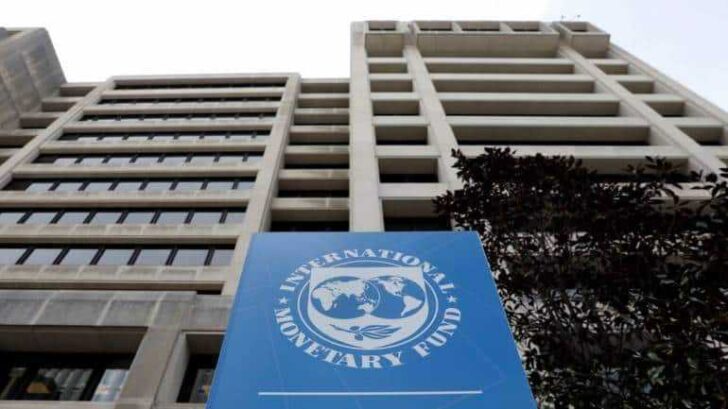The International Monetary Fund on April 16 raised India’s FY25 GDP growth forecast by 30 bps to 6.8% from its January forecast of 6.5% citing bullish domestic demand conditions and a rising working-age population.
With this, India continues to be the fastest growing economy of the world, ahead of China’s growth projection of 4.6% during the same period.
IMF sees India’s FY26 GDP growth at 6.5%. The global financial agency sees India’s retail inflation at 4.6% in FY25 and 4.2% in FY26.
“Growth in India is projected to remain strong at 6.8% in 2024 and 6.5% in 2025, with the robustness reflecting continuing strength in domestic demand and a rising working-age population,” said the latest edition of the World Economic Outlook released by the IMF ahead of the annual spring meetings of the IMF and the World Bank.
At the same time, growth in emerging and developing Asia is expected to fall from an estimated 5.6% in 2023 to 5.2% in 2024 and 4.9% in 2025, a slight upward revision compared with the January 2024 WEO Update.
“Growth in China is projected to slow from 5.2% in 2023 to 4.6% in 2024 and 4.1% in 2025, as the positive effects of one-off factors including the post pandemic boost to consumption and fiscal stimulus ease and weakness in the property sector persists,” the IMF said.
The global economy is set for another year of slow but steady growth, the IMF said on April 16, with US strength pushing world output through headwinds from lingering high inflation, weak demand in China and Europe, and spillovers from two regional wars.
The IMF forecast global real GDP growth of 3.2% for 2024 and 2025 – the same rate as in 2023. The 2024 forecast was revised upward by 0.1 percentage point from the previous World Economic Outlook’s estimate in January, largely due to a significant upward revision in the U.S. outlook.
“We find that the global economy remains quite resilient,” Pierre-Olivier Gourinchas, the IMF’s chief economist, told reporters, adding that many countries have defied gloomy predictions of recession as central banks hiked interest rates to fight inflation.
Many countries also are showing less “scarring” from the COVID-19 pandemic and cost-of-living crises, returning to pre-pandemic levels of output more quickly than previously predicted, the IMF said in its report.
Inflation is falling, but progress in bringing it back to central bank targets has slowed in recent months, Gourinchas said, noting that recent U.S. data shows robust demand.
“The general trajectory still remains one where we expect inflation to come down over the year and put the Federal Reserve in a position where it will be able to start easing the policy rates,” he told Reuters. “Maybe not as quickly as what the markets had expected.”
The IMF forecast 2024 U.S. growth of 2.7% compared to the 2.1% projected in January, on stronger-than-expected employment and consumer spending at the end of 2023 and into 2024. It expects the delayed effect of tighter monetary and fiscal policy to slow U.S. growth to 1.9% in 2025, though that also was an upward revision from the 1.7% estimate in January.
But the latest IMF forecasts showed stark divergences with other countries, including in the euro zone, where the 2024 growth forecast was revised downward to 0.8% from 0.9% in January, primarily due to weak consumer sentiment in Germany and France. Britain’s 2024 growth forecast also was revised down by 0.1 percentage point to 0.5% as the country struggles with high interest rates and stubbornly high inflation.
CHINA PROPERTY WOES
The IMF left unchanged its forecast for China’s 2024 growth to fall to 4.6% from 5.2% in 2023, with a further drop to 4.1% for 2025. But it warned that the lack of a comprehensive restructuring package for the country’s troubled property sector could prolong a downturn in domestic demand and worsen China’s outlook.
Such a situation could also intensify deflationary pressures in China’s economy, leading to a surge in cheap exports of manufactured goods that could stoke trade retaliation by other countries – a scenario that U.S. Treasury Secretary Janet Yellen warned about during a trip to China earlier this month.
The IMF recommended that China accelerate the exit of non-viable developers and promote the completion of unfinished housing projects, while supporting vulnerable households to help restore consumer demand.
But the global lender noted bright spots in some other big emerging market countries, raising its growth forecast for Brazil’s economy in 2024 by half a percentage point to 2.2% and increasing the forecast for India’s economic growth by 0.3 percentage point to 6.8%.
It noted that Group of 20 large emerging market countries are now playing a bigger role in the global trading system and have the capability to shoulder more of the growth burden going forward.
But the IMF said low-income developing countries continue to struggle with post-pandemic adjustments and greater levels of economic “scarring” than middle-income emerging markets. As a group, these low-income developing countries saw their 2024 growth forecast cut to 4.7% from an estimate of 4.9% in January.


Leave a Reply